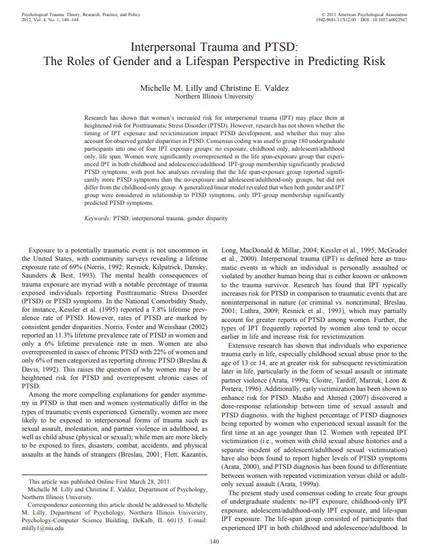
Article
Interpersonal Trauma and PTSD: The Roles of Gender and a Lifespan Perspective in Predicting Risk
Psychological Trauma: Theory, Research, Practice, and Policy
(2012)
Abstract
Research has shown that women's increased risk for interpersonal trauma (IPT) may place them at heightened risk for PTSD. However, research has not shown whether the timing of IPT exposure and revictimization impact PTSD development, and whether this may also account for observed gender disparities in PTSD. Consensus coding was used to group 180 undergraduate participants into one of four IPT exposure groups: no exposure, childhood only, adolescent/adulthood only, life span. Women were significantly overrepresented in the life span-exposure group that experienced IPT in both childhood and adolescence/adulthood. IPT-group membership significantly predicted PTSD symptoms, with post hoc analyses revealing that the life span-exposure group reported significantly more PTSD symptoms than the no-exposure and adolescent/adulthood-only groups, but did not differ from the childhood-only group. A generalized linear model revealed that when both gender and IPT group were considered in relationship to PTSD symptoms, only IPT-group membership significantly predicted PTSD symptoms.
Keywords
- PTSD,
- interpersonal trauma,
- gender disparity
Disciplines
Publication Date
January, 2012
DOI
10.1037/a0022947
Citation Information
Lilly, M. M., & Valdez, C. E. (2012). Interpersonal trauma and PTSD: The roles of gender and a lifespan perspective in predicting risk. Psychological Trauma: Theory, Research, Practice, and Policy, 4(1), 140-144. http://dx.doi.org/10.1037/a0022947
